Race Face Next R31 Wheelset
Internal Rim Width (measured): 31 mm
External Rim Width (measured): 37.5 mm
Blister’s Measured Weight (29”; Boost; XD; includes tape and valve):
- Front: 824 g
- Rear: 931 g
- Total: 1755 g
MSRP: $1500
Bolted to: Trek Slash 9.8
Reviewerr: 5’9” 155 lbs.
Test Locations: Lots places west of the Mighty Mississippi and east of the Vast Pacific
Test Duration: ~4 months
Intro
Wheels can be tricky to review — it’s easy to hop on a wheelset for a couple of rides and come to the conclusion that they’re awesome. And it’s not too hard to make a fairly light, fairly stiff wheelset that’s going to impress… at first. But wheels take a beating, and there’s no shortage of wheels that don’t stand the test of time.
Fortunately, I’ve had the chance to put quite a bit of time on the Race Face Next R wheelset — I’ve logged over 1,000 miles on them since they showed up on my doorstep earlier this summer. And those miles haven’t been easy on the wheels — as I’ve mentioned previously, I raced them in the Trans BC, I’ve done a couple DH races on them, I’ve guinea-pigged assorted jumps and drops with varying degrees of success on them, and that’s all on top of my usual laissez-faire attitude towards anything maintenance related.
Specs, Features, and Options
The Next R wheels are available in two widths — the R31 that I tested, and the R36, which have a 31 mm and 36 mm internal widths, respectively. Both widths are available in 27.5” and 29” iterations, and the hubs are available in non-boost (12 x 142 / 15 x 100), boost (12 x 148 / 15 x 110), as well as the new superboost width (12 x 157 / 15 x 110) . With different end caps (sold separately), the non-boost hubs are convertible to quick release as well as 20 mm front axles, and all of the front hubs can be converted to run torque caps for Sram forks.
The Next R wheels are built around Race Face’s Vault hubs, which run an oversize hub shell that’s bigger than most of the common hubs on the market (more on that below). The hubs have oversized bearings, and they’re available with both XD drivers and Shimano Freehubs. As of this writing, they’re not available with Shimano’s new MicroSpline freehub, but Race Face says they’re working on that.
Engagement on the rear hub is via six double-tooth pawls of which three engage at a time, yielding 120 points of engagement. That’s an engagement point every 3°, which is quite good — it’s the same as Industry Nine hubs, and more than any hubs from DT Swiss, Shimano, or Sram.
While there are a few varieties of Vault hubs, the ones used in the Next R wheelsets have 28 straight-pull spokes, both front and rear. The hub flanges are also different sizes, which, combined with the offset rim, results in the extremely convenient conclusion that only one spoke length is used throughout the wheelset.
The Next R31 wheels I tested measure 31 mm internally, and they feature a 4.5 mm offset, meaning that the spokes holes are offset to one side of the rim. There was a time when that sort of offset wasn’t very common, but these days there are a number of companies doing it. And for good reason — the offset rim allows for the single spoke length mentioned above, but more importantly, it means that each side of the spokes approaches the rim at closer to the same angle.
Bike wheels, and particularly rear wheels, are asymmetrical — the spokes from the drive side approach the rim at a steeper angle than the spokes on the non-drive side. That steeper drive-side spoke angle makes it harder to build a strong, stiff wheel, but offsetting the rim helps even out the spoke angles, making for an all-round superior wheel.
The spokes on the wheels I tested are made by Pillar, which is a brand a lot of people might not be familiar with, but they’re straight-pull, butted, and don’t visibly look all that different from a lot of other spokes on the market. Newer versions of the Next R wheels, including all of the R36, come with Sapim D-Light spokes, which I think is a good thing (I’ll get into that more below).
Setup Notes
The Next R Wheels come with tubeless rim tape and valves already installed, so setting the tires up tubeless is entirely easy. Mounting tires reveals these rims to be pretty tight — with an assortment of tires from a couple different brands, I found these rims to require a bit more work to get the rubber on and off.
One particular set of tires (a WTB Vigilante 2.6 and Trail Boss 2.6 — reviews to come) were what I would describe as infuriatingly tight — to remove the tires, I had to use a carpenter’s clamp on the tire to get enough leverage to break the bead loose. Part of that tightness is just the tires (WTB’s tend to be on the tight side), but I think part of the reason is also the rim’s extra-deep bead hook — the little channel on the inside of the rim that the bead hooks into. And while that deep hook makes tires pretty tight on the rim, it also means it’ll take some serious doing to burp a tire.
One other note, the Next R’s stock rim tape is great, but I had to remove it to replace a spoke (foreshadowing). When I re-taped the rim, I used Gorilla tape, because that’s what I had lying around. When I inflated the tire, it promptly blew off the rim, leaving me sticky and deaf. That leads me to the conclusion that Gorilla tape might be too thick for these rims. I re-taped (again) with thinner Stan’s tape and haven’t had any issues since.
On the Trail
From the get-go, I was pretty psyched on these wheels, mostly because the specs checked all the boxes. The rim width is, at least for me, perfect. At 31 mm, the rim works well with everything from 2.3” to 2.6” tires, which is what I run 99% of the time. A lot of bikes are coming with 35 mm rims these days, but I’m of the opinion that those are too wide to really work well with a 2.3” tire, which I use quite often in the rear. But if your tire widths of choice range between 2.4” and 2.8”, check out the Race Face Next R36 — that width will work a bit better with those wider tires.
Aside from the rim width, I’m a sucker for good hub engagement, and with 120 points, the Vault hubs are great. That quick engagement makes it easier to ratchet my way up technical climbs, and it makes it easier to give a quick ¼ pedal stroke when I bog down in a corner and need to get back up to speed. Now, that quick engagement does come at the cost of a bit more rolling resistance, but that difference is nominal, and I’d argue that it’s pretty much irrelevant on a mountain bike.
One thing that people ask about higher-engagement hubs is how loud they are, because they tend to be noisy. The Vault hubs aren’t super loud — they’re quieter than Industry 9 and Chris King hubs, but they’re louder than DT Swiss hubs.
And aside from the rim and hub specs, the Next R31 wheels weigh in at around 1750 grams, which is respectably light, especially for something with a ~30 mm rim.
As far as riding any given wheelset goes, the question for me usually comes down to stiffness. I have ridden some carbon wheelsets that I’d argue are a bit too stiff. They can feel chattery in rough corners, and on shorter-travel bikes, they tend to feel pretty punishing on my spine.
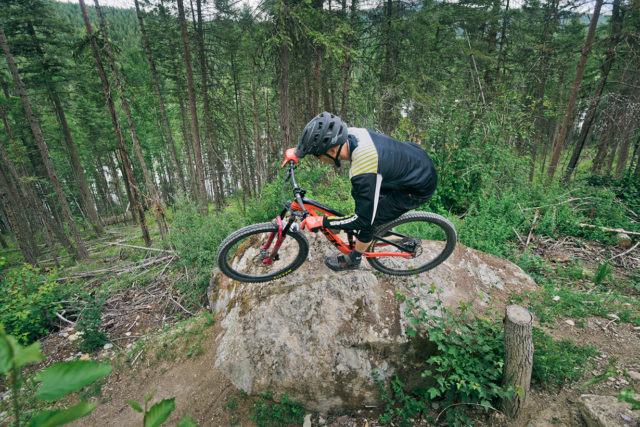
The Next R wheels are at the stiff end of the spectrum, but without feeling too stiff. Some of this undoubtedly comes from a fairly stout rim, and some of it likely comes from the relatively short spoke length that’s the result of those oversized hub shells.
Mounting up the Next R’s onto the Trek Slash 9.8, there was a massively noticeable difference in stiffness compared to that bike’s stock Bontrager wheels. With the Next R, pushing hard into corners yielded minimal lateral flex, and hard compressions never resulted in that sort of mushy, wiggly feeling that flexier wheels tend to exhibit.
Occasionally, on some exceptionally rough corners, there were times where I wondered if a slightly “softer” wheel would have helped a bit more with traction, but it’s always tough to tell in those situations because there’s so much going on. Tire pressure and suspension setup tend to have a significantly more noticeable effect, so arriving at a tidy conclusion regarding wheel stiffness and traction is tricky. And regardless of whether a softer wheel would help in that scenario, I’m positive that the stiffer wheel helped keep the bike on-line in pretty much any on-camber corner where the wheel is getting a fair amount of lateral force put into it — pushing hard into a berm with a stiff wheel is a lot more confidence inspiring than on a flexy wheel.
Stiffer, burlier-feeling wheels like the Next R also invite some more aggressive cornering techniques that feel hack-ish, but they work (sometimes). There have been plenty of times where I’ve overcooked a corner and I’m in danger of running wide. But I can sort of fix that by unweighting the back end of the bike and letting the rear wheel sputter over to the outside edge of the trail, effectively giving me some oversteer. With flexier wheels, that maneuver tends to be a little less successful — a softer wheel doesn’t really like getting tossed sideways. But with a stiffer wheel like the Next R, it works. Or at the very least, the success rate of the maneuver is less affected by the wheel stiffness, and if / when it doesn’t work, it’s because I screwed it up.
Durability
Here’s where we get down to the meat and potatoes of the wheel review — how’d they hold up?
The rims are still going strong, and judging by their cosmetic appearance, they’ve taken a beating. I’ve had quite a few rim strikes, a couple of pinched tires, and lots of pushing the wheel sideways through fist-sized rocks, all of which have yielded a bunch of cosmetic scratches but nothing that’s structurally concerning. There have been a few instances where I fully tagged a rock at speed — enough to make me stop and inspect the rim, and … nothing. And doing a more detailed inspection with the tire removed revealed … again, nothing. The stickers on the rims are pretty chewed up though.
Similarly, the hubs are doing great. They still spin smoothly, there’s no play whatsoever, and the pawls are still engaging consistently and firmly. I can count on one hand the number of times the hub skipped or popped, and even in those instances, it was pretty minor compared to what I’ve had happen from lots of other hub brands.
Which brings us to the one hiccup: the spokes. They’ve started breaking. I’m at the point where I’m breaking a spoke on the rear wheel roughly every third ride — apparently, they’ve just reached their fatigue limit. And to be clear, the spokes are still holding tension, the wheel is still true, and aside from replacing the broken spokes, I’ve had to do zero work to the rear wheel to keep it running. But frequently breaking spokes is pretty frustrating — having to re-tape the rim and re-install tires gets old pretty quickly.
Now, this issue isn’t specific to the Next R in my experience — I’ve had similar issues with wheels from a number of other companies that use narrower-gauge spokes (*cough* Roval). One or two spokes could be a fluke, but beyond that, I’ve found that once they start breaking, the wheel pretty much needs to be fully re-laced with fresh spokes.
The upside here is that the newer Next R wheels (including all of the R36’s) use Sapim D-Light spokes, and generally speaking, I’ve had good luck with Sapim spokes.
I should also note that Race Face offers a no-questions-asked, two-year guarantee on these wheels.
According to Race Face: “At the discretion of Race Face we will, within 2 years of your original purchase, repair or replace your carbon wheel regardless of how the damage occurred or what the damage is. This guarantee covers your complete carbon wheel, including the rim, spokes, and hub with bearings to ensure you have a fully functioning, ride-ready wheel.”
So (1) that means my issues with the spokes would almost certainly be covered, and (2) the fact that the guarantee covers damage regardless of how it happens is noteworthy. There are plenty of carbon warranties in the industry, some of which are “lifetime warranties.” But most of those warranties only cover manufacturing defects. But if you back your car over your Next R’s within the first two years, you’re covered.
I don’t want to sound like an apologist here — just because something is covered under a warranty doesn’t mean it’s a good product. And the fact that the spokes started breaking is definitely a mark against these wheels. My point is more that I’ve had similar things happen with a bunch of other wheels from other companies, often times with far fewer miles on them, so the Next R wheels aren’t alone in this issue. And while they aren’t clearly superior, they also aren’t unusually bad among comparable wheels on the market.
Bottom Line
The Next R31 wheels have a whole lot to like — for most Trail / Enduro type bikes, I think they’re the right width, the hubs are fantastic, and the rims hit a nice tripoint of weight, stiffness, and durability.
The low point of my wheels was the spokes and their too-short fatigue life, but newer versions of the wheels come with different spokes, and at least the wheel would be covered under Race Face’s guarantee. Given that I’ve ridden plenty of other wheels that have had similar issues with the spokes, I have a hard time using that as a reason to point people away from these wheels. And to be sure, if I wasn’t hacking the bike sideways through rocks, the spokes would probably last a lot longer.
On top of all of that, at $1500, the Next R wheels are pretty reasonably priced for what they offer. Yes, it pains me a little bit to call a $1500 wheelset reasonably priced, but such is the world we live in. And there aren’t many other wheelsets that are offering a similar set of features, backed by a similar guarantee at that price point.

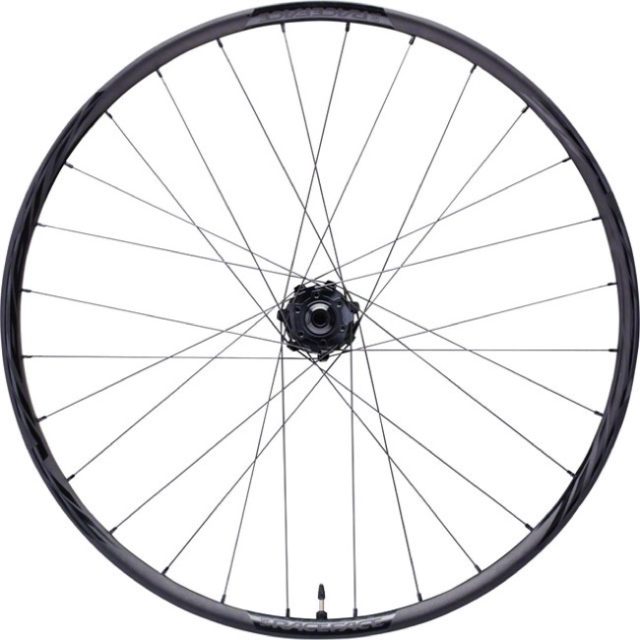
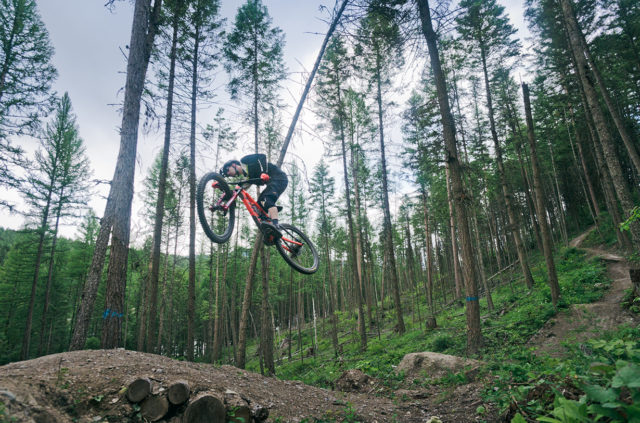
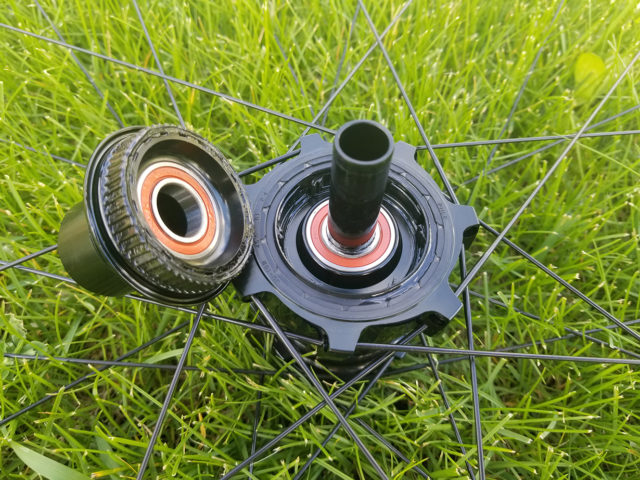
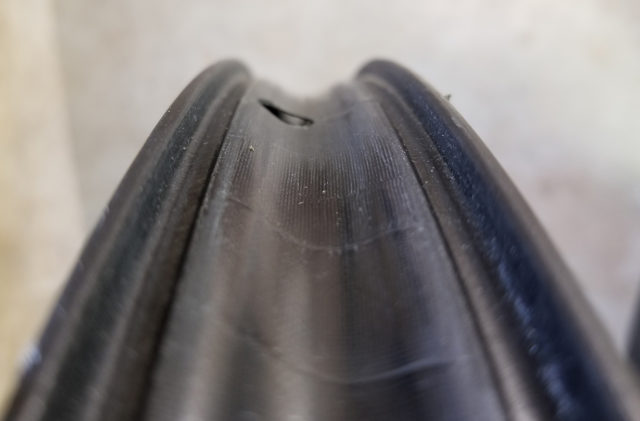
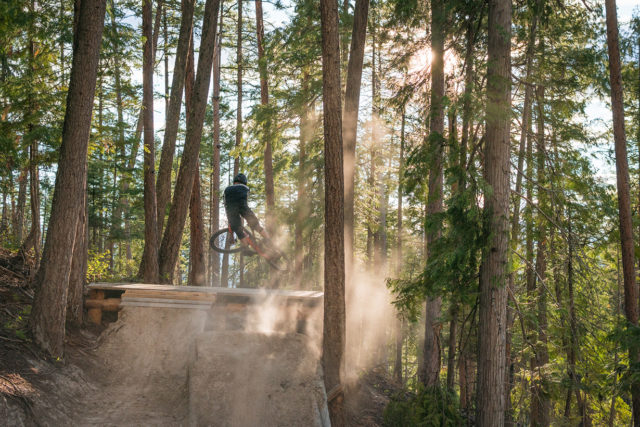
OK that worked so. Firstly, great review as always! Best reviews out there imo.
Here is my question: I am planning to run a 2.6 vigilante and am struggling to decide on the rim width that is right for me. As a reference point, I ran a 2.5 vigilante on a 35mm rim and it came up quite square so I would prefer a more rounded profile. Do you suggest me to go with the R31 or R36?
I have not yet seen a 2.6 in vig in the wild and since you tried it with these rims your opinion is exactly what I am looking for. Given your review above it sounds like you suggest the 2.6 fits better on a 35mm rim? I also run a 2.6 DHF on a 35mm rim and think it is just about perfect. Would like juuuuuust a bit rounder profile.
please let me know what you think. Can’t wait for the 2.5/2.6 Vigilante review! Thanks!
I’ve been running the 2.6 Vigilante on 30-ish mm rims. I had them on these Next R31’s for a while, and I’ve also run them on the stock Bontrager wheels that came on my Trek as well as some Enve M7’s, which are both 30mm wide. I like the profile of the tire on those rims – rounded enough that it’s hard to lean the bike past the side knobs, but not too rounded. I’d say go with a ~30mm rim unless you have a strong preference towards squared off tires, or if you plan on running 2.8’s at some point in the future.
I’d also say that, for any given 2.6 tire, the difference between mounting it on a 30mm rim vs a 35mm isn’t enormous. There’s a difference, for sure, but I don’t find it to be night and day, and I think that particular tire width works pretty well on either rim size. It’s mostly a difference of a slightly rounder profile and ~30-50 grams of weight savings on the narrower rim, vs. a squarer profile and a little more sidewall support that maybe allows you to drop 1psi.
Hope that helps!
Also, a sneak preview: 2.6 Vigilante’s are great. Really similar to the narrower Vigilante except more of everything. More traction and better braking, but also more rolling resistance. The 2.6 Trail Boss is actually the one I’m more excited about – it’s a good bit different than the narrower versions of the tire.
Thanks Noah! I actually am going to try a 2.6 on the 35mm rims that I have to test and decide what width to go on my next bike. Will be riding tomorrow so will report back with my findings! Have a great thanksgiving! Can’t wait for your review! Will post up some comments on my review as well when you post is up! Cheers!
Noah, your first inclination is to blame spoke gauge/brand for the early breakage woes, what about spoke count or shape? Roval wheels resemble these not just in their choice of skinny spokes, but also in a tendency to skimp on spokes (28 or less) and run straight pull hubs. Every experience I’ve had w/ chronic spoke breakage, noise, & tension loss has been on low-spoke count wheels, and straight pull hubs typically amplify these problems. Conversely, I currently have two sets of 32-spoke, J-bend wheels built w/ ultralight CX-Ray spokes that have been hammered 3-4000miles each w/o a single broken spoke. Perhaps I’ve unconsciously selected gear just to confirm my own bias: the industry sure seems to want to sell me low-spoke, straight pull wheels these days. If you filter your experience of breaking spokes on recent wheel designs through this lens, do you get similar results, or can you think of examples that buck the trend?
Hey Matt,
All good points, but I think it gets a bit more complicated. The problem I see is that these wheels (and others like them) are using a pretty burly carbon rim. And generally speaking, that’s good – the rim’s decently light, and it holds up well to abuse. But it also makes for a really stiff rim, which is why some carbon wheels actually feel a bit too stiff. So companies like Raceface build a bit of compliance into the wheels by reducing the spoke count and using narrow gauge spokes (which has the side benefit of saving a bit of weight). But then, of course, we run into durability problems like I had.
The answer, like you said, is to bump up the spoke count, or use thicker gauge spokes. But then the wheel starts to be really, really stiff. So the other answer, like you also said, is to use really high quality spokes like the CX-Rays. And I’m with you – wheels I’ve run with CX-Rays (even when there’s just 28 of them) have held up really well. The only problem there is that CX-Rays cost about 2.5x as much as Sapim D-Lights, so if these wheels came with CX-Rays, that’d probably bump the price of the wheelset up to $1700-1800.
As far as the straight pull vs. j bend thing – straight pull’s are easier to lace, which makes it a little less expensive to produce the wheels. Personally, I’d prefer a j-bend build, but it’s not something that really makes or breaks a wheel for me. And for whatever it’s worth, none of the spokes I broke on the R31’s were near the hub end of the spoke. Most of them broke at the start of the threads, at the nipple.
So I’m not sure I have an answer to the problems here. Or, more accurately, all of the answers have noteworthy downsides either in the form of ride quality or cost (not to mention weight). That’s kind of an unsatisfying conclusion, but such is life. Now I’ve just gotta decide if I want to drop $100 on spokes to rebuild the rear wheel with CS-Rays…
Great review, as just about always. Bummer about the spoke failures, though. So close!
Two questions:
1. You mentioned these were stiffer than the stock Bontragers on your Slash. Which Bontrager wheels were those? Carbon or aluminum, and straight pull bladed or j-bend round spokes?
2. I would LOVE a bit more info on the carpenter’s clamp tire removal method. I’ve run into this problem before, and don’t even want to publicly admit some of the things I’ve tried…..
Happy Thanksgiving Blister Members!
Hey Tom,
1) The Bontrager wheels were Line Elite 30’s. So straight pull double butted (14/15 I think) spokes, aluminum rim with a 30 mm internal width. Decent wheels, all in all, but definitely not as stiff (laterally or vertically) as the Next R’s.
2) It wasn’t anything particularly tricky – I just clamped the tire as close to the bead as I could and used the clamps as a lever to peel the tire off the rim. And while I said it was a carpenter’s clamp, I think technically it was a c-clamp. It basically just gave me a bit of extra leverage to get the bead to pop in one spot, and from there, the rest was easy.
Happy turky day!
-Noah
Thanks! Your removal method is similar to mine. I clamp the tire in a bench vise (after padding the jaws), then kind of torque back and forth on the wheel. Sometimes it takes doing this in three or four positions before the bead lets go. Always makes me wonder how I’d fare on the trail in this situation………..
Just bought a Next R31 wheelset (29, boost, SRAM XD). How can I tell
whether the spokes are Pillar or Sapim?
The Sapims should say “Sapim” on the side of the spoke, near the hub end. Pillars have sort of a cursive, capital “P” on the spoke head. This page has a pretty good list of how to differentiate different spokes: http://www.mrrabbit.net/docs/spokeheads/main.html
The issue with the spokes on the 31mm rims, is due to poor drilling angles on the rims themselves, in my opinion. I’ve had 6 of these rims come across my bench. 27.5 being worse than the 29 versions I’ve handled.
The drilling angle is certainly a possible culprit, but if that was the cause, I’d expect the failures I had to all be at the nipple. And really, I’d kind of expect the failure to be the nipple itself (since they’re aluminum). But the failures I had were all over the spoke – one or two at the base of the threads, one at the thickness transition at the butt, and a couple at random spots in the middle of the spoke. That variability makes me more inclined to think that it’s just an issue with metal in the spokes fatiguing over time. But I can’t be sure.
I’m planning on relacing the wheel with some Sapim CX-Rays, so we’ll see how those hold up.
-Noah
Noah, feel free to shoot me an email (provided when posting this?) and I’ll give you some more detailed thoughts on my opinion. I even have some great pictures to illustrate my opinion, and I’m happy to explain why they shouldn’t and wouldn’t crack at the nipple, even if alloy, and why they are cracking at the base of the thread and at the butt, and possibly mid spoke. I don’t want to hijack your review by writing a novel underneath it!
Cheers
Mark
How was your long term experience with these. I just purchased a set of the 36 version for my Trek EXe. Thanks!
Great review. I am hesitating wether to purchase Next 30 or Turbine 30. I demo’ed an Orbea Rise with Turbine wheels and the ride was awesome. I am going to purchase that bike and I don’t know if carbon rim stiffness could do any bad to the awesome handling in the descents.
Thanks!